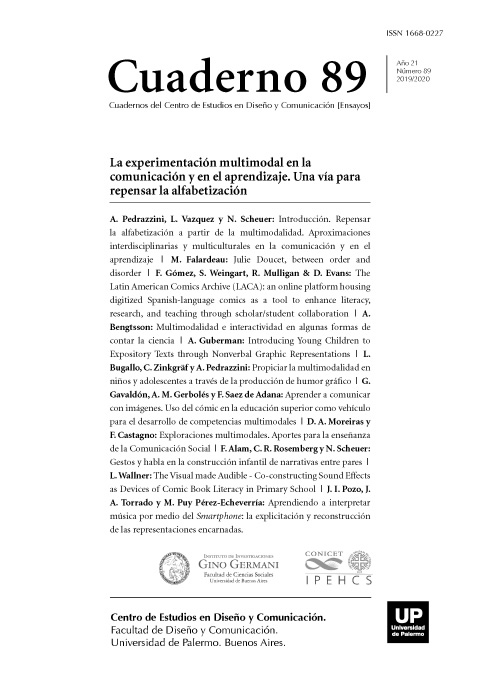Julie Doucet, between order and disorder
Abstract
This article intends to present and analyse the links between two types of discourse in the creations of the Montrealer artist, Julie Doucet. The comix chosen is Dirty Plotte, number 5, published in 1992 by Drawn & Quarterly (Montreal) and republished in French in 2013 as Fantastic Plotte by L’Oie de Cravan (Montreal). We first present the artist Doucet, secondly, we examine the story of What an Intense City, and thirdly, the synopsis of Missing. Subsequently, we analyse the two types of discourse, comparing the underground language used in the first work to the conventional one used in Missing, observing the image as well as the narration. Our hypothesis is that the creation of Missing, one of the most brilliant works of Doucet, was possible because of her ability to understand the two different languages and to go from one to the other. The analysis considers iconic elements and rhetorical figures. The detailed analysis of diverse elements of background and characters will reveal a strong contrast between both works. The deciphering of rhetorical figures, narrative as well as visual, will demonstrate how the practice of an alternative and experimental art succeeded in enriching the artist and gave her tools to communicate with all types of public in respect of conventional codes. Between three cultures, Doucet, a francophone who writes in English with “the accent”, plays on several levels and her discourse creates links between American and Canadian underground, the art of Montreal metropolis and the cheeky humour of French alternative press.
References
Airault, R. (2000). Fous de l’Inde. Paris: Payot.
Bergson, H. (1901, 1972). Le rire. Paris : Presses universitaires de France.
Brown, A. (2017). The Madame Paul Affair. In BDQ, Essays and Interviews on Quebec Comics. Nova Scotia: Conundrum Press. Originally published in The Montreal Review of Books (2001).
Doucet, J. (1990). Dirty Plotte, 14 issues. Montreal: Drawn & Quarterly.
Doucet, J. (1993). Lève ta jambe, mon poisson est mort. Montreal: Drawn & Quarterly.
Doucet, J. (1994). Monkey and the Living Dead. Chacal puant.
Doucet, J. (1995). My most secret desire. Montreal: Drawn & Quarterly.
Doucet, J. (1996). Ciboire de criss. Paris : L’Association.
Doucet, J. (1998). Changements d’adresse. Paris : L’Association.
Doucet, J. (1999, 2000). L’affaire Madame Paul. The Madame Paul Affair. Montreal: L’Oie de Cravan. Montreal: Drawn & Quarterly.
Falardeau, M. (2008). Histoire de la bande dessinée au Québec. Montreal: VLB Ed.
Falardeau, M. (2015). Humour et liberté d’expression. Les langages de l’humour. Quebec : Presses de l’Université Laval.
Freud, S. (1905, 1960). Der witz und seine besiehung zum unbewussten. The Joke and its Relation to the Unconscious. NewYork: Norton.
Gombrich, E. (1960). Art and Illusion. London: Phaidon.
Melot, M. (1975). L’oeil qui rit. Le pouvoir comique des images. Fribourg : L’office du livre
Noguez, D. (1974). Petite rhétorique de poche pour servir à la lecture des dessins d’humour. In L’art de masse n’existe pas. Revue d’esthétique 3/4, 107-137
Watson, J. (2010). Alison Bechdel’s Fun Home. In Cagney, M.A. (Ed.) Graphics Subjects. Madison: University of Wisconsin Press, 125.
Los autores/as que publiquen en esta revista ceden los derechos de autor y de publicación a "Cuadernos del Centro de Estudios de Diseño y Comunicación", Aceptando el registro de su trabajo bajo una licencia de atribución de Creative Commons, que permite a terceros utilizar lo publicado siempre que de el crédito pertinente a los autores y a esta revista.


